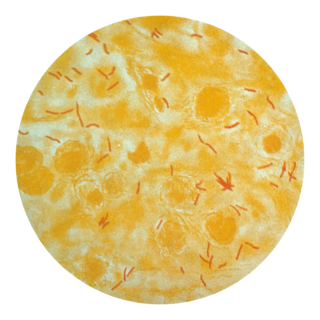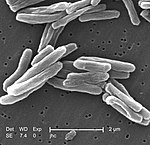Related Research Articles

Bacillus Calmette–Guérin (BCG) vaccine is a vaccine primarily used against tuberculosis (TB). It is named after its inventors Albert Calmette and Camille Guérin. In countries where tuberculosis or leprosy is common, one dose is recommended in healthy babies as soon after birth as possible. In areas where tuberculosis is not common, only children at high risk are typically immunized, while suspected cases of tuberculosis are individually tested for and treated. Adults who do not have tuberculosis and have not been previously immunized, but are frequently exposed, may be immunized, as well. BCG also has some effectiveness against Buruli ulcer infection and other nontuberculous mycobacterial infections. Additionally, it is sometimes used as part of the treatment of bladder cancer.

Tuberculosis (TB) is an infectious disease usually caused by Mycobacterium tuberculosis (MTB) bacteria. Tuberculosis generally affects the lungs, but it can also affect other parts of the body. Most infections show no symptoms, in which case it is known as latent tuberculosis. Around 10% of latent infections progress to active disease which, if left untreated, kill about half of those affected. Typical symptoms of active TB are chronic cough with blood-containing mucus, fever, night sweats, and weight loss. It was historically referred to as consumption due to the weight loss associated with the disease. Infection of other organs can cause a wide range of symptoms.

The Mantoux test or Mendel–Mantoux test is a tool for screening for tuberculosis (TB) and for tuberculosis diagnosis. It is one of the major tuberculin skin tests used around the world, largely replacing multiple-puncture tests such as the tine test. The Heaf test, a form of tine test, was used until 2005 in the UK, when it was replaced by the Mantoux test. The Mantoux test is endorsed by the American Thoracic Society and Centers for Disease Control and Prevention. It was also used in the USSR and is now prevalent in most of the post-Soviet states, although Soviet mantoux produced many false positives due to children's allergic reaction.

Mycobacterium tuberculosis, also known as Koch's bacillus, is a species of pathogenic bacteria in the family Mycobacteriaceae and the causative agent of tuberculosis. First discovered in 1882 by Robert Koch, M. tuberculosis has an unusual, waxy coating on its cell surface primarily due to the presence of mycolic acid. This coating makes the cells impervious to Gram staining, and as a result, M. tuberculosis can appear weakly Gram-positive. Acid-fast stains such as Ziehl–Neelsen, or fluorescent stains such as auramine are used instead to identify M. tuberculosis with a microscope. The physiology of M. tuberculosis is highly aerobic and requires high levels of oxygen. Primarily a pathogen of the mammalian respiratory system, it infects the lungs. The most frequently used diagnostic methods for tuberculosis are the tuberculin skin test, acid-fast stain, culture, and polymerase chain reaction.

Mycobacterium is a genus of over 190 species in the phylum Actinomycetota, assigned its own family, Mycobacteriaceae. This genus includes pathogens known to cause serious diseases in mammals, including tuberculosis and leprosy in humans. The Greek prefix myco- means 'fungus', alluding to this genus' mold-like colony surfaces. Since this genus has cell walls with a waxy lipid-rich outer layer that contains high concentrations of mycolic acid, acid-fast staining is used to emphasize their resistance to acids, compared to other cell types.
Nontuberculous mycobacteria (NTM), also known as environmental mycobacteria, atypical mycobacteria and mycobacteria other than tuberculosis (MOTT), are mycobacteria which do not cause tuberculosis or leprosy. NTM do cause pulmonary diseases that resemble tuberculosis. Mycobacteriosis is any of these illnesses, usually meant to exclude tuberculosis. They occur in many animals, including humans and are commonly found in soil and water.

The tine test is a multiple-puncture tuberculin skin test used to aid in the medical diagnosis of tuberculosis (TB). The tine test is similar to the Heaf test, although the Mantoux test is usually used instead. There are multiple forms of the tine tests which usually fall into two categories: the old tine test (OT) and the purified protein derivative (PPD) tine test. Common brand names of the test include Aplisol, Aplitest, Tuberculin PPD TINE TEST, and Tubersol.

Tuberculosis is diagnosed by finding Mycobacterium tuberculosis bacteria in a clinical specimen taken from the patient. While other investigations may strongly suggest tuberculosis as the diagnosis, they cannot confirm it.

Tuberculin, also known as purified protein derivative, is a combination of proteins that are used in the diagnosis of tuberculosis. This use is referred to as the tuberculin skin test and is recommended only for those at high risk. Reliable administration of the skin test requires large amounts of training, supervision, and practice. Injection is done into the skin. After 48 to 72 hours, if there is more than a five to ten millimeter area of swelling, the test is considered positive.

Miliary tuberculosis is a form of tuberculosis that is characterized by a wide dissemination into the human body and by the tiny size of the lesions (1–5 mm). Its name comes from a distinctive pattern seen on a chest radiograph of many tiny spots distributed throughout the lung fields with the appearance similar to millet seeds—thus the term "miliary" tuberculosis. Miliary TB may infect any number of organs, including the lungs, liver, and spleen. Miliary tuberculosis is present in about 2% of all reported cases of tuberculosis and accounts for up to 20% of all extra-pulmonary tuberculosis cases.

Rifabutin (Rfb) is an antibiotic used to treat tuberculosis and prevent and treat Mycobacterium avium complex. It is typically only used in those who cannot tolerate rifampin such as people with HIV/AIDS on antiretrovirals. For active tuberculosis it is used with other antimycobacterial medications. For latent tuberculosis it may be used by itself when the exposure was with drug-resistant TB.
Latent tuberculosis (LTB), also called latent tuberculosis infection (LTBI) is when a person is infected with Mycobacterium tuberculosis, but does not have active tuberculosis. Active tuberculosis can be contagious while latent tuberculosis is not, and it is therefore not possible to get TB from someone with latent tuberculosis. The main risk is that approximately 10% of these people will go on to develop active tuberculosis. This is particularly true, and there is added risk, in particular situations such as medication that suppresses the immune system or advancing age.
rBCG30 is a prospective vaccine against tuberculosis created by a team headed by Marcus A. Horwitz at UCLA. It is a live vaccine, consisting of BCG genetically modified to produce abundant amounts of a 30kDa antigen that has been shown to produce a strong immune response in animals and humans. The vaccine completed a Phase I double-blind randomized controlled clinical trial that demonstrated that rBCG30 was safe and immunogenic; during nine months of follow-up, rBCG30, but not BCG, induced significantly increased Antigen 85B-specific immune responses in eight immunological assays.
Lipoarabinomannan, also called LAM, is a glycolipid, and a virulence factor associated with Mycobacterium tuberculosis, the bacteria responsible for tuberculosis. Its primary function is to inactivate macrophages and scavenge oxidative radicals.
Interferon-γ release assays (IGRA) are medical tests used in the diagnosis of some infectious diseases, especially tuberculosis. Interferon-γ (IFN-γ) release assays rely on the fact that T-lymphocytes will release IFN-γ when exposed to specific antigens. These tests are mostly developed for the field of tuberculosis diagnosis, but in theory, may be used in the diagnosis of other diseases which rely on cell-mediated immunity, e.g. cytomegalovirus and leishmaniasis and COVID-19. For example, in patients with cutaneous adverse drug reactions, challenge of peripheral blood lymphocytes with the drug causing the reaction produced a positive test result for half of the drugs tested.
Interferon-gamma release assays (IGRAs) are diagnostic tools for latent tuberculosis infection (LTBI). They are surrogate markers of Mycobacterium tuberculosis infection and indicate a cellular immune response to M. tuberculosis if the latter is present.
ESAT-6 or Early Secreted Antigenic Target 6 kDa, is produced by Mycobacterium tuberculosis, it is a secretory protein and potent T cell antigen. It is used in tuberculosis diagnosis by the whole blood interferon γ test QuantiFERON-TB Gold, in conjunction with CFP-10.

CFP-10 within bacterial proteins is a protein that is encoded by the esxB gene.
The antibodies from lymphocyte secretions (ALS) assay is an immunological assay to detect active diseases like tuberculosis, cholera, typhoid etc. Recently, ALS assay nods the scientific community as it is rapidly used for diagnosis of Tuberculosis. The principle is based on the secretion of antibody from in vivo activated plasma B cells found in blood circulation for a short period of time in response to TB-antigens during active TB infection rather than latent TB infection.

Lalita Ramakrishnan is an Indian-born American microbiologist who is known for her contributions to the understanding of the biological mechanism of tuberculosis. As of 2019 she serves as a professor of Immunology and Infectious Diseases at the University of Cambridge, where she is also a Wellcome Trust Principal Research Fellow and a practicing physician. Her research is conducted at the MRC Laboratory of Molecular Biology, where she serves as the Head of the Molecular Immunity Unit of the Department of Medicine embedded at the MRC LMB. Working with Stanley Falkow at Stanford, she developed the strategy of using Mycobacterium marinum infection as a model for tuberculosis. Her work has appeared in a number of journals, including Science, Nature, and Cell. In 2018 and 2019 Ramakrishnan coauthored two influential papers in the British Medical Journal (BMJ) arguing that the widely accepted estimates of the prevalence of latent tuberculosis—estimates used as a basis for allocation of research funds—are far too high. She is married to Mark Troll, a physical chemist.
References
- ↑ http://www.isis-innovation.com/news/news/oxfordimmunotec-nov02.html%5B%5D
- ↑ "How T-SPOT.TB Works".
- ↑ Meier, T.; Eulenbruch, H.-P.; Wrighton-Smith, P.; Enders, G.; Regnath, T. (2005). "Sensitivity of a new commercial enzyme-linked immunospot assay (T SPOT-TB) for diagnosis of tuberculosis in clinical practice". European Journal of Clinical Microbiology & Infectious Diseases . 24 (8): 529–36. doi:10.1007/s10096-005-1377-8. PMID 16133410. S2CID 9400363.
- ↑ Bamford, A. R J; Crook, A. M; Clark, J. E; Nademi, Z.; Dixon, G.; Paton, J. Y; Riddell, A.; Drobniewski, F.; Riordan, A. (2009). "Comparison of interferon- release assays and tuberculin skin test in predicting active tuberculosis (TB) in children in the UK: A paediatric TB network study". Archives of Disease in Childhood. 95 (3): 180–6. doi:10.1136/adc.2009.169805. PMID 19815937. S2CID 7665520.
- ↑ Ritz, Nicole; Connell, Tom G.; Paxton, Georgia A.; Buttery, Jim P.; Curtis, Nigel; Ranganathan, Sarath C. (2008). Dheda, Keertan (ed.). "A Three-Way Comparison of Tuberculin Skin Testing, QuantiFERON-TB Gold and T-SPOT.TB in Children". PLOS ONE. 3 (7): e2624. Bibcode:2008PLoSO...3.2624C. doi: 10.1371/journal.pone.0002624 . PMC 2440545 . PMID 18612425.

- ↑ Connell, Thomas G.; Tebruegge, Marc; Ritz, Nicole; Bryant, Penelope A.; Leslie, David; Curtis, Nigel (2010). "Indeterminate Interferon-γ Release Assay Results in Children". The Pediatric Infectious Disease Journal. 29 (3): 285–6. doi: 10.1097/INF.0b013e3181c4822f . PMID 20190616.
- ↑ Connell, T. G.; Tebruegge, M.; Ritz, N.; Bryant, P.; Curtis, N. (2010). "The potential danger of a solely interferon-γ release assay-based approach to testing for latent Mycobacterium tuberculosis infection in children". Thorax. 66 (3): 263–4, author reply 265. doi: 10.1136/thx.2010.143396 . PMID 20980248.
- ↑ Mandalakas, A. M.; Detjen, A. K.; Hesseling, A. C.; Benedetti, A.; Menzies, D. (2011). "Interferon-gamma release assays and childhood tuberculosis: Systematic review and meta-analysis". The International Journal of Tuberculosis and Lung Disease. 15 (8): 1018–32. doi:10.5588/ijtld.10.0631. PMID 21669030.
